SS428 Labour Studies Essay: Globalisation, Sweatshops & Canada Impact
VerifiedAdded on 2023/05/30
|7
|1691
|199
Essay
AI Summary
This essay examines the impact of globalisation and sweatshops on the Canadian labour market, focusing on the garment industry and the ethical implications of sweatshop labour. It discusses the reasons for the prevalence of sweatshops in countries like Bangladesh and the factors influencing Canadian consumers' purchase of sweatshop-produced goods. The essay highlights the complex supply chains that obscure the origins of products and the economic factors that drive young girls to work in garment factories. It also addresses the potential consequences of job loss for these workers and concludes by emphasizing the need for greater awareness and ethical considerations in the global market. Desklib offers similar essays and study resources to aid students in their academic pursuits.

Running head: LABOUR STUDIES
Labour studies
Student’s Name
University Name
Author’s Note
Labour studies
Student’s Name
University Name
Author’s Note
Paraphrase This Document
Need a fresh take? Get an instant paraphrase of this document with our AI Paraphraser
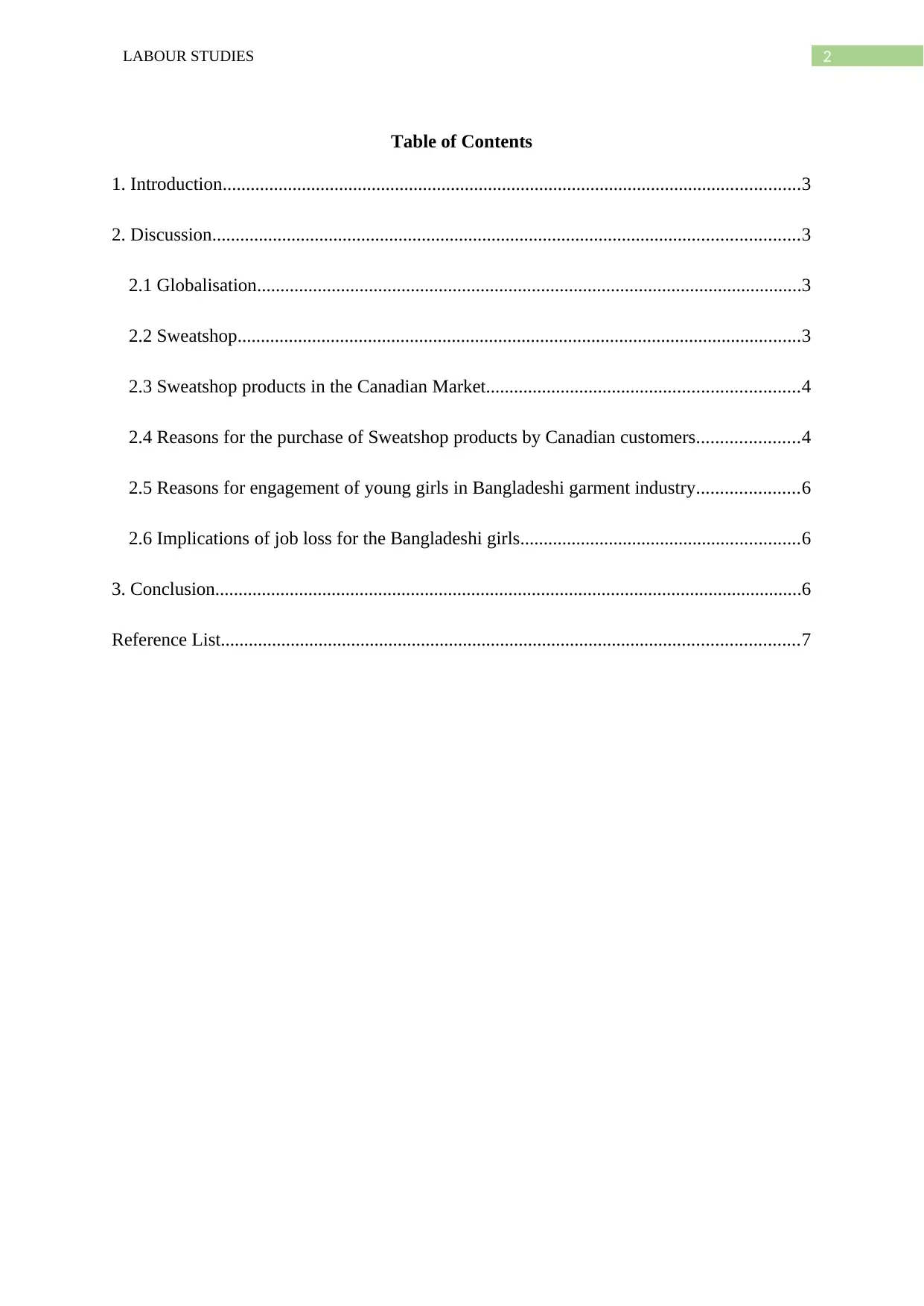
2LABOUR STUDIES
Table of Contents
1. Introduction............................................................................................................................3
2. Discussion..............................................................................................................................3
2.1 Globalisation.....................................................................................................................3
2.2 Sweatshop.........................................................................................................................3
2.3 Sweatshop products in the Canadian Market...................................................................4
2.4 Reasons for the purchase of Sweatshop products by Canadian customers......................4
2.5 Reasons for engagement of young girls in Bangladeshi garment industry......................6
2.6 Implications of job loss for the Bangladeshi girls............................................................6
3. Conclusion..............................................................................................................................6
Reference List............................................................................................................................7
Table of Contents
1. Introduction............................................................................................................................3
2. Discussion..............................................................................................................................3
2.1 Globalisation.....................................................................................................................3
2.2 Sweatshop.........................................................................................................................3
2.3 Sweatshop products in the Canadian Market...................................................................4
2.4 Reasons for the purchase of Sweatshop products by Canadian customers......................4
2.5 Reasons for engagement of young girls in Bangladeshi garment industry......................6
2.6 Implications of job loss for the Bangladeshi girls............................................................6
3. Conclusion..............................................................................................................................6
Reference List............................................................................................................................7
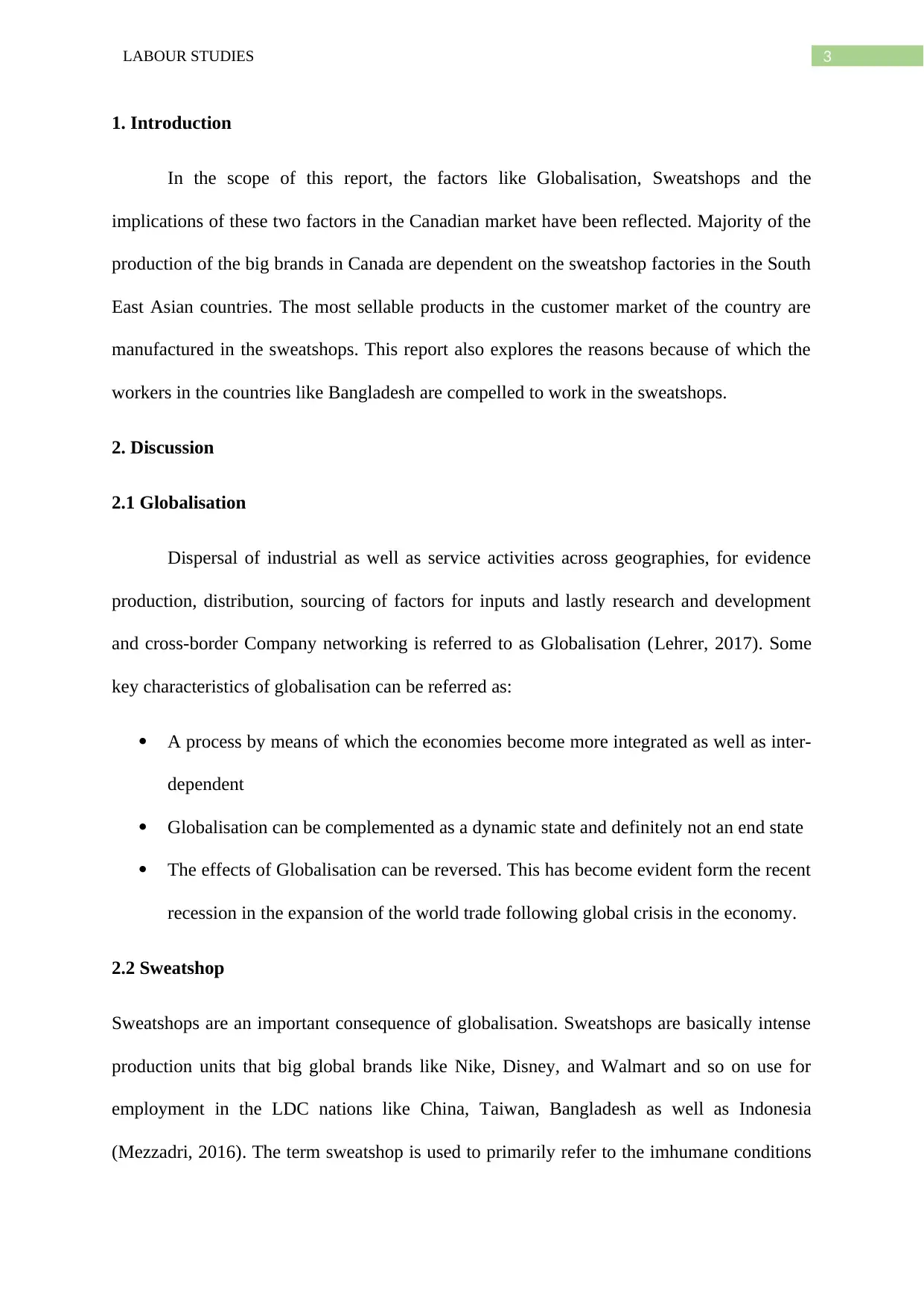
3LABOUR STUDIES
1. Introduction
In the scope of this report, the factors like Globalisation, Sweatshops and the
implications of these two factors in the Canadian market have been reflected. Majority of the
production of the big brands in Canada are dependent on the sweatshop factories in the South
East Asian countries. The most sellable products in the customer market of the country are
manufactured in the sweatshops. This report also explores the reasons because of which the
workers in the countries like Bangladesh are compelled to work in the sweatshops.
2. Discussion
2.1 Globalisation
Dispersal of industrial as well as service activities across geographies, for evidence
production, distribution, sourcing of factors for inputs and lastly research and development
and cross-border Company networking is referred to as Globalisation (Lehrer, 2017). Some
key characteristics of globalisation can be referred as:
A process by means of which the economies become more integrated as well as inter-
dependent
Globalisation can be complemented as a dynamic state and definitely not an end state
The effects of Globalisation can be reversed. This has become evident form the recent
recession in the expansion of the world trade following global crisis in the economy.
2.2 Sweatshop
Sweatshops are an important consequence of globalisation. Sweatshops are basically intense
production units that big global brands like Nike, Disney, and Walmart and so on use for
employment in the LDC nations like China, Taiwan, Bangladesh as well as Indonesia
(Mezzadri, 2016). The term sweatshop is used to primarily refer to the imhumane conditions
1. Introduction
In the scope of this report, the factors like Globalisation, Sweatshops and the
implications of these two factors in the Canadian market have been reflected. Majority of the
production of the big brands in Canada are dependent on the sweatshop factories in the South
East Asian countries. The most sellable products in the customer market of the country are
manufactured in the sweatshops. This report also explores the reasons because of which the
workers in the countries like Bangladesh are compelled to work in the sweatshops.
2. Discussion
2.1 Globalisation
Dispersal of industrial as well as service activities across geographies, for evidence
production, distribution, sourcing of factors for inputs and lastly research and development
and cross-border Company networking is referred to as Globalisation (Lehrer, 2017). Some
key characteristics of globalisation can be referred as:
A process by means of which the economies become more integrated as well as inter-
dependent
Globalisation can be complemented as a dynamic state and definitely not an end state
The effects of Globalisation can be reversed. This has become evident form the recent
recession in the expansion of the world trade following global crisis in the economy.
2.2 Sweatshop
Sweatshops are an important consequence of globalisation. Sweatshops are basically intense
production units that big global brands like Nike, Disney, and Walmart and so on use for
employment in the LDC nations like China, Taiwan, Bangladesh as well as Indonesia
(Mezzadri, 2016). The term sweatshop is used to primarily refer to the imhumane conditions
⊘ This is a preview!⊘
Do you want full access?
Subscribe today to unlock all pages.

Trusted by 1+ million students worldwide
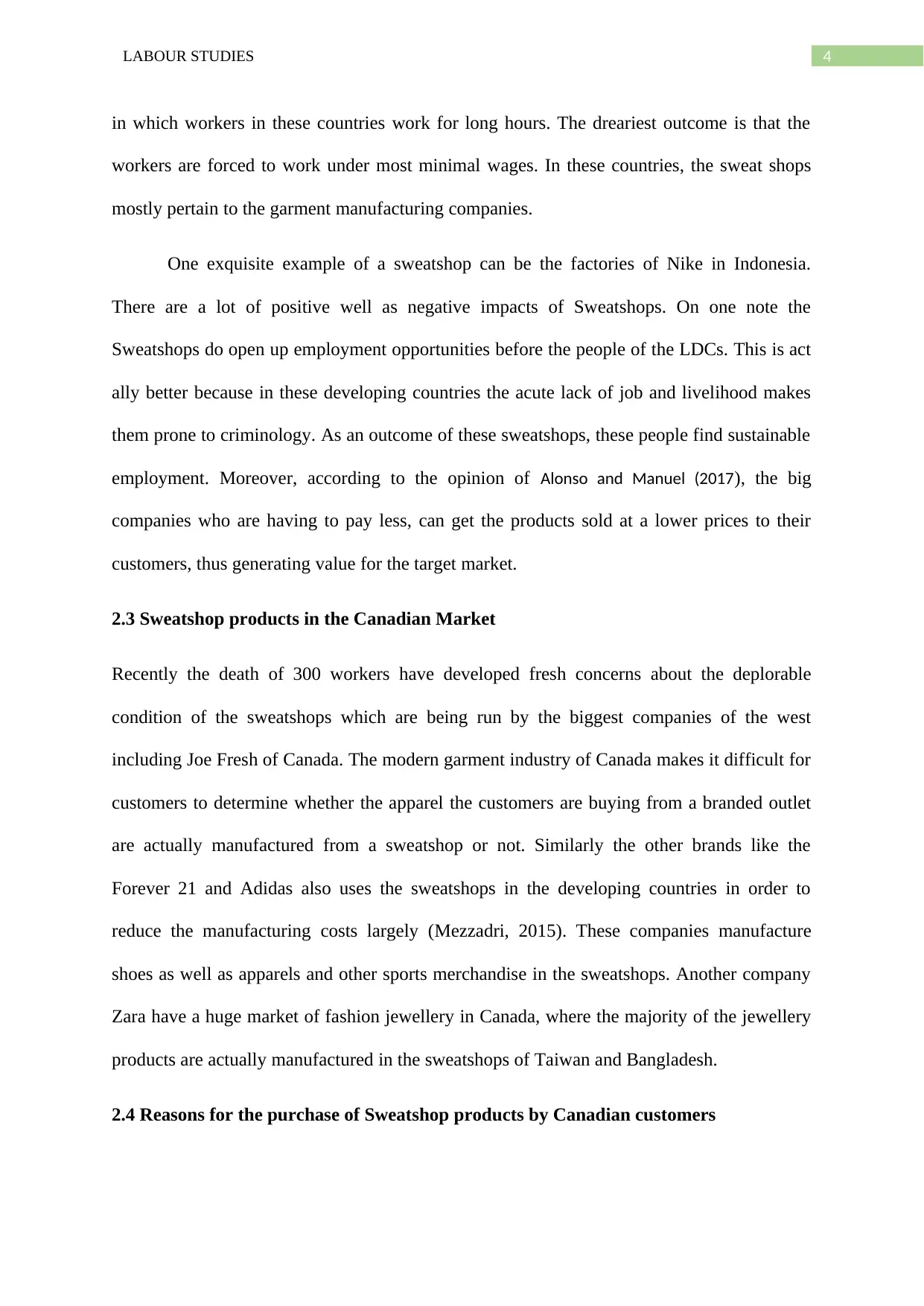
4LABOUR STUDIES
in which workers in these countries work for long hours. The dreariest outcome is that the
workers are forced to work under most minimal wages. In these countries, the sweat shops
mostly pertain to the garment manufacturing companies.
One exquisite example of a sweatshop can be the factories of Nike in Indonesia.
There are a lot of positive well as negative impacts of Sweatshops. On one note the
Sweatshops do open up employment opportunities before the people of the LDCs. This is act
ally better because in these developing countries the acute lack of job and livelihood makes
them prone to criminology. As an outcome of these sweatshops, these people find sustainable
employment. Moreover, according to the opinion of Alonso and Manuel (2017), the big
companies who are having to pay less, can get the products sold at a lower prices to their
customers, thus generating value for the target market.
2.3 Sweatshop products in the Canadian Market
Recently the death of 300 workers have developed fresh concerns about the deplorable
condition of the sweatshops which are being run by the biggest companies of the west
including Joe Fresh of Canada. The modern garment industry of Canada makes it difficult for
customers to determine whether the apparel the customers are buying from a branded outlet
are actually manufactured from a sweatshop or not. Similarly the other brands like the
Forever 21 and Adidas also uses the sweatshops in the developing countries in order to
reduce the manufacturing costs largely (Mezzadri, 2015). These companies manufacture
shoes as well as apparels and other sports merchandise in the sweatshops. Another company
Zara have a huge market of fashion jewellery in Canada, where the majority of the jewellery
products are actually manufactured in the sweatshops of Taiwan and Bangladesh.
2.4 Reasons for the purchase of Sweatshop products by Canadian customers
in which workers in these countries work for long hours. The dreariest outcome is that the
workers are forced to work under most minimal wages. In these countries, the sweat shops
mostly pertain to the garment manufacturing companies.
One exquisite example of a sweatshop can be the factories of Nike in Indonesia.
There are a lot of positive well as negative impacts of Sweatshops. On one note the
Sweatshops do open up employment opportunities before the people of the LDCs. This is act
ally better because in these developing countries the acute lack of job and livelihood makes
them prone to criminology. As an outcome of these sweatshops, these people find sustainable
employment. Moreover, according to the opinion of Alonso and Manuel (2017), the big
companies who are having to pay less, can get the products sold at a lower prices to their
customers, thus generating value for the target market.
2.3 Sweatshop products in the Canadian Market
Recently the death of 300 workers have developed fresh concerns about the deplorable
condition of the sweatshops which are being run by the biggest companies of the west
including Joe Fresh of Canada. The modern garment industry of Canada makes it difficult for
customers to determine whether the apparel the customers are buying from a branded outlet
are actually manufactured from a sweatshop or not. Similarly the other brands like the
Forever 21 and Adidas also uses the sweatshops in the developing countries in order to
reduce the manufacturing costs largely (Mezzadri, 2015). These companies manufacture
shoes as well as apparels and other sports merchandise in the sweatshops. Another company
Zara have a huge market of fashion jewellery in Canada, where the majority of the jewellery
products are actually manufactured in the sweatshops of Taiwan and Bangladesh.
2.4 Reasons for the purchase of Sweatshop products by Canadian customers
Paraphrase This Document
Need a fresh take? Get an instant paraphrase of this document with our AI Paraphraser
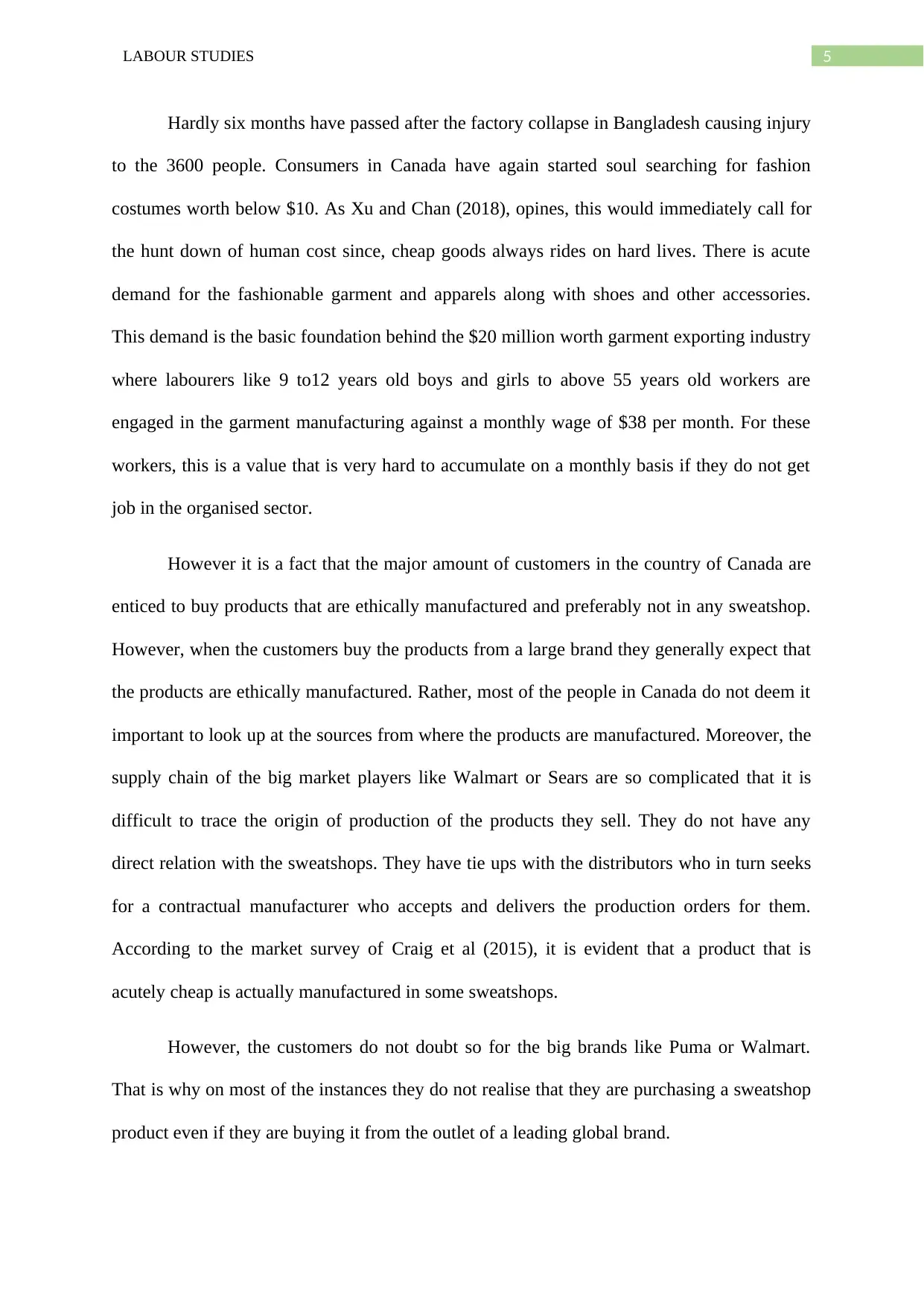
5LABOUR STUDIES
Hardly six months have passed after the factory collapse in Bangladesh causing injury
to the 3600 people. Consumers in Canada have again started soul searching for fashion
costumes worth below $10. As Xu and Chan (2018), opines, this would immediately call for
the hunt down of human cost since, cheap goods always rides on hard lives. There is acute
demand for the fashionable garment and apparels along with shoes and other accessories.
This demand is the basic foundation behind the $20 million worth garment exporting industry
where labourers like 9 to12 years old boys and girls to above 55 years old workers are
engaged in the garment manufacturing against a monthly wage of $38 per month. For these
workers, this is a value that is very hard to accumulate on a monthly basis if they do not get
job in the organised sector.
However it is a fact that the major amount of customers in the country of Canada are
enticed to buy products that are ethically manufactured and preferably not in any sweatshop.
However, when the customers buy the products from a large brand they generally expect that
the products are ethically manufactured. Rather, most of the people in Canada do not deem it
important to look up at the sources from where the products are manufactured. Moreover, the
supply chain of the big market players like Walmart or Sears are so complicated that it is
difficult to trace the origin of production of the products they sell. They do not have any
direct relation with the sweatshops. They have tie ups with the distributors who in turn seeks
for a contractual manufacturer who accepts and delivers the production orders for them.
According to the market survey of Craig et al (2015), it is evident that a product that is
acutely cheap is actually manufactured in some sweatshops.
However, the customers do not doubt so for the big brands like Puma or Walmart.
That is why on most of the instances they do not realise that they are purchasing a sweatshop
product even if they are buying it from the outlet of a leading global brand.
Hardly six months have passed after the factory collapse in Bangladesh causing injury
to the 3600 people. Consumers in Canada have again started soul searching for fashion
costumes worth below $10. As Xu and Chan (2018), opines, this would immediately call for
the hunt down of human cost since, cheap goods always rides on hard lives. There is acute
demand for the fashionable garment and apparels along with shoes and other accessories.
This demand is the basic foundation behind the $20 million worth garment exporting industry
where labourers like 9 to12 years old boys and girls to above 55 years old workers are
engaged in the garment manufacturing against a monthly wage of $38 per month. For these
workers, this is a value that is very hard to accumulate on a monthly basis if they do not get
job in the organised sector.
However it is a fact that the major amount of customers in the country of Canada are
enticed to buy products that are ethically manufactured and preferably not in any sweatshop.
However, when the customers buy the products from a large brand they generally expect that
the products are ethically manufactured. Rather, most of the people in Canada do not deem it
important to look up at the sources from where the products are manufactured. Moreover, the
supply chain of the big market players like Walmart or Sears are so complicated that it is
difficult to trace the origin of production of the products they sell. They do not have any
direct relation with the sweatshops. They have tie ups with the distributors who in turn seeks
for a contractual manufacturer who accepts and delivers the production orders for them.
According to the market survey of Craig et al (2015), it is evident that a product that is
acutely cheap is actually manufactured in some sweatshops.
However, the customers do not doubt so for the big brands like Puma or Walmart.
That is why on most of the instances they do not realise that they are purchasing a sweatshop
product even if they are buying it from the outlet of a leading global brand.
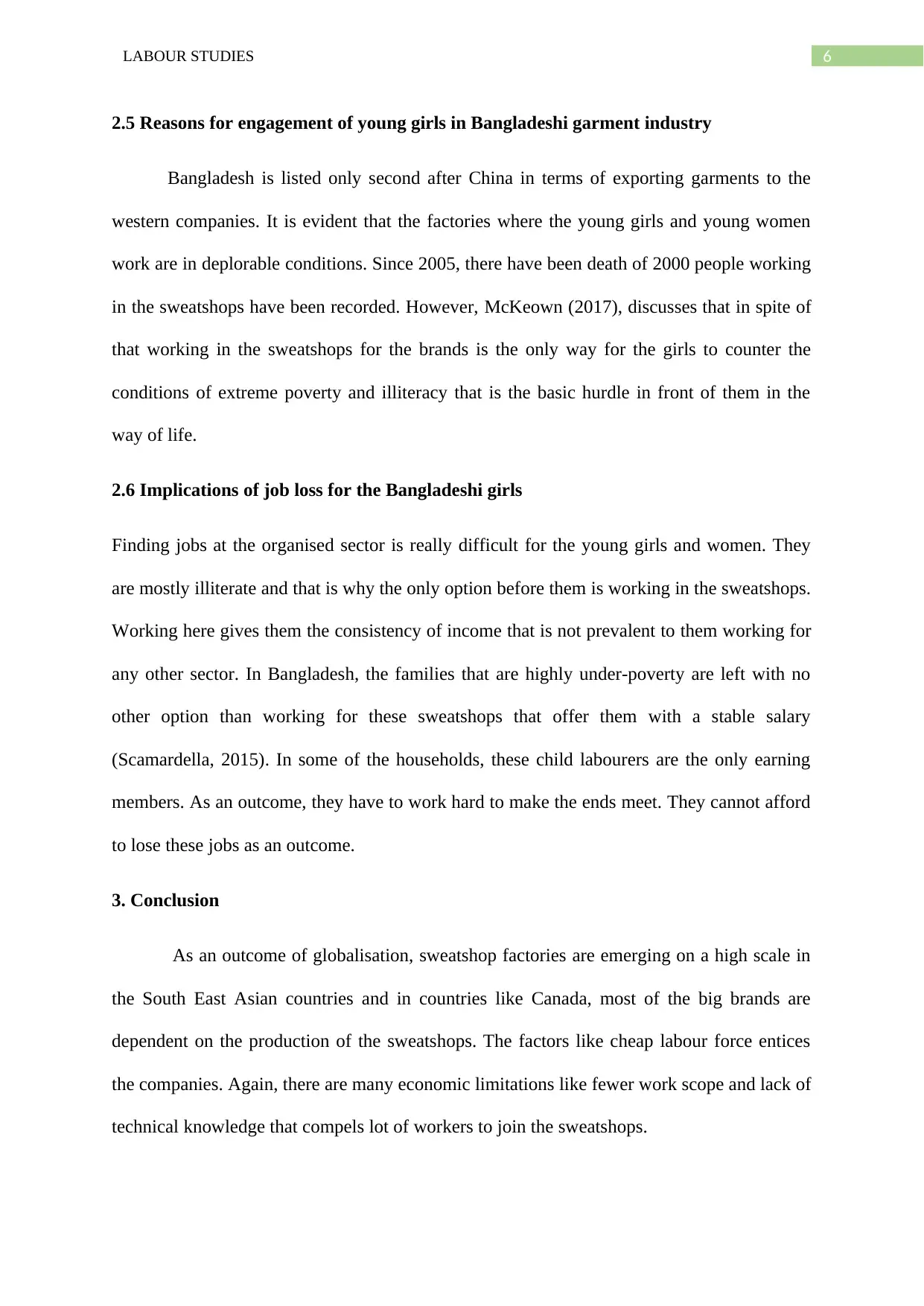
6LABOUR STUDIES
2.5 Reasons for engagement of young girls in Bangladeshi garment industry
Bangladesh is listed only second after China in terms of exporting garments to the
western companies. It is evident that the factories where the young girls and young women
work are in deplorable conditions. Since 2005, there have been death of 2000 people working
in the sweatshops have been recorded. However, McKeown (2017), discusses that in spite of
that working in the sweatshops for the brands is the only way for the girls to counter the
conditions of extreme poverty and illiteracy that is the basic hurdle in front of them in the
way of life.
2.6 Implications of job loss for the Bangladeshi girls
Finding jobs at the organised sector is really difficult for the young girls and women. They
are mostly illiterate and that is why the only option before them is working in the sweatshops.
Working here gives them the consistency of income that is not prevalent to them working for
any other sector. In Bangladesh, the families that are highly under-poverty are left with no
other option than working for these sweatshops that offer them with a stable salary
(Scamardella, 2015). In some of the households, these child labourers are the only earning
members. As an outcome, they have to work hard to make the ends meet. They cannot afford
to lose these jobs as an outcome.
3. Conclusion
As an outcome of globalisation, sweatshop factories are emerging on a high scale in
the South East Asian countries and in countries like Canada, most of the big brands are
dependent on the production of the sweatshops. The factors like cheap labour force entices
the companies. Again, there are many economic limitations like fewer work scope and lack of
technical knowledge that compels lot of workers to join the sweatshops.
2.5 Reasons for engagement of young girls in Bangladeshi garment industry
Bangladesh is listed only second after China in terms of exporting garments to the
western companies. It is evident that the factories where the young girls and young women
work are in deplorable conditions. Since 2005, there have been death of 2000 people working
in the sweatshops have been recorded. However, McKeown (2017), discusses that in spite of
that working in the sweatshops for the brands is the only way for the girls to counter the
conditions of extreme poverty and illiteracy that is the basic hurdle in front of them in the
way of life.
2.6 Implications of job loss for the Bangladeshi girls
Finding jobs at the organised sector is really difficult for the young girls and women. They
are mostly illiterate and that is why the only option before them is working in the sweatshops.
Working here gives them the consistency of income that is not prevalent to them working for
any other sector. In Bangladesh, the families that are highly under-poverty are left with no
other option than working for these sweatshops that offer them with a stable salary
(Scamardella, 2015). In some of the households, these child labourers are the only earning
members. As an outcome, they have to work hard to make the ends meet. They cannot afford
to lose these jobs as an outcome.
3. Conclusion
As an outcome of globalisation, sweatshop factories are emerging on a high scale in
the South East Asian countries and in countries like Canada, most of the big brands are
dependent on the production of the sweatshops. The factors like cheap labour force entices
the companies. Again, there are many economic limitations like fewer work scope and lack of
technical knowledge that compels lot of workers to join the sweatshops.
⊘ This is a preview!⊘
Do you want full access?
Subscribe today to unlock all pages.

Trusted by 1+ million students worldwide
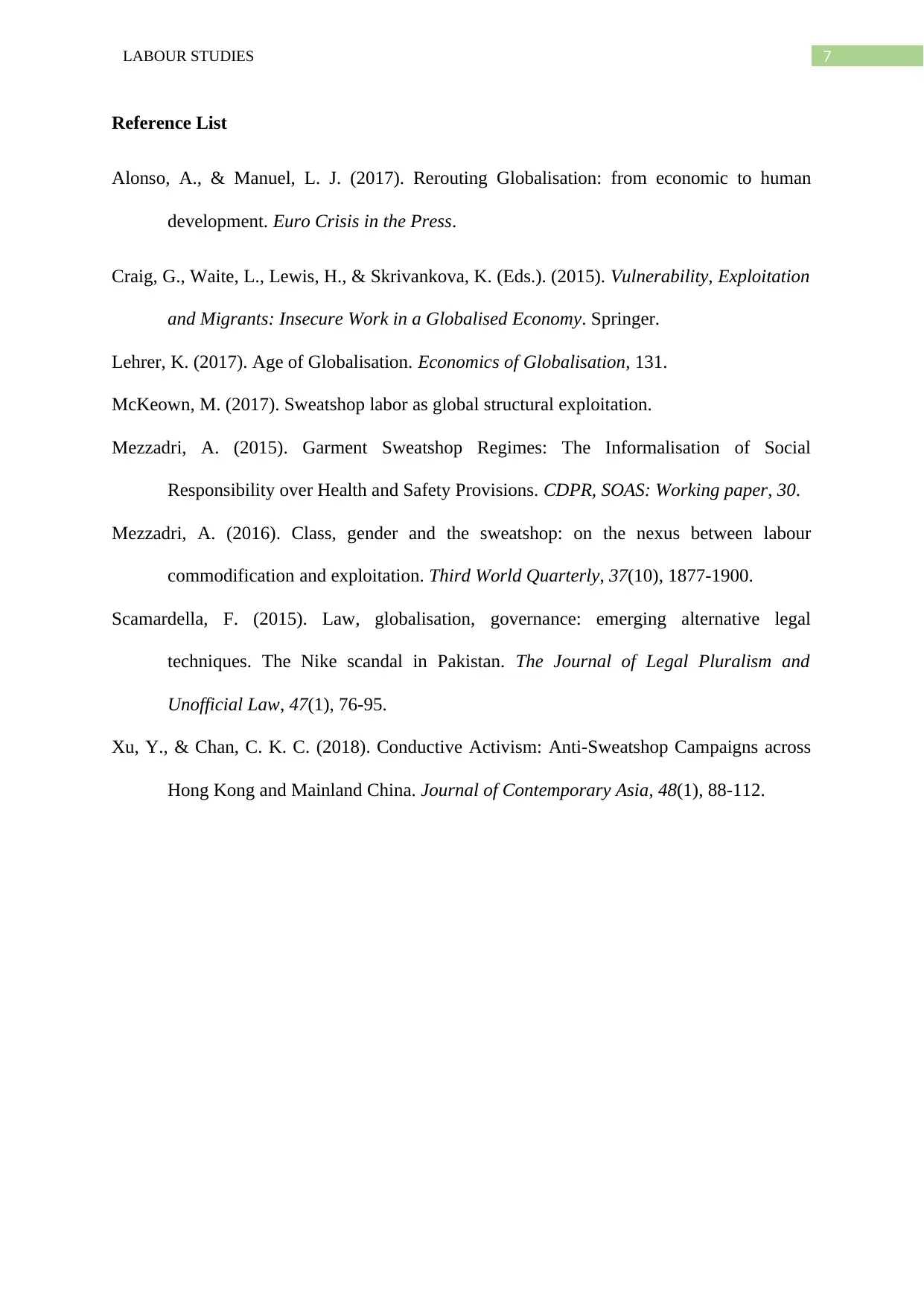
7LABOUR STUDIES
Reference List
Alonso, A., & Manuel, L. J. (2017). Rerouting Globalisation: from economic to human
development. Euro Crisis in the Press.
Craig, G., Waite, L., Lewis, H., & Skrivankova, K. (Eds.). (2015). Vulnerability, Exploitation
and Migrants: Insecure Work in a Globalised Economy. Springer.
Lehrer, K. (2017). Age of Globalisation. Economics of Globalisation, 131.
McKeown, M. (2017). Sweatshop labor as global structural exploitation.
Mezzadri, A. (2015). Garment Sweatshop Regimes: The Informalisation of Social
Responsibility over Health and Safety Provisions. CDPR, SOAS: Working paper, 30.
Mezzadri, A. (2016). Class, gender and the sweatshop: on the nexus between labour
commodification and exploitation. Third World Quarterly, 37(10), 1877-1900.
Scamardella, F. (2015). Law, globalisation, governance: emerging alternative legal
techniques. The Nike scandal in Pakistan. The Journal of Legal Pluralism and
Unofficial Law, 47(1), 76-95.
Xu, Y., & Chan, C. K. C. (2018). Conductive Activism: Anti-Sweatshop Campaigns across
Hong Kong and Mainland China. Journal of Contemporary Asia, 48(1), 88-112.
Reference List
Alonso, A., & Manuel, L. J. (2017). Rerouting Globalisation: from economic to human
development. Euro Crisis in the Press.
Craig, G., Waite, L., Lewis, H., & Skrivankova, K. (Eds.). (2015). Vulnerability, Exploitation
and Migrants: Insecure Work in a Globalised Economy. Springer.
Lehrer, K. (2017). Age of Globalisation. Economics of Globalisation, 131.
McKeown, M. (2017). Sweatshop labor as global structural exploitation.
Mezzadri, A. (2015). Garment Sweatshop Regimes: The Informalisation of Social
Responsibility over Health and Safety Provisions. CDPR, SOAS: Working paper, 30.
Mezzadri, A. (2016). Class, gender and the sweatshop: on the nexus between labour
commodification and exploitation. Third World Quarterly, 37(10), 1877-1900.
Scamardella, F. (2015). Law, globalisation, governance: emerging alternative legal
techniques. The Nike scandal in Pakistan. The Journal of Legal Pluralism and
Unofficial Law, 47(1), 76-95.
Xu, Y., & Chan, C. K. C. (2018). Conductive Activism: Anti-Sweatshop Campaigns across
Hong Kong and Mainland China. Journal of Contemporary Asia, 48(1), 88-112.
1 out of 7
Related Documents
Your All-in-One AI-Powered Toolkit for Academic Success.
+13062052269
info@desklib.com
Available 24*7 on WhatsApp / Email
![[object Object]](/_next/static/media/star-bottom.7253800d.svg)
Unlock your academic potential
Copyright © 2020–2025 A2Z Services. All Rights Reserved. Developed and managed by ZUCOL.




